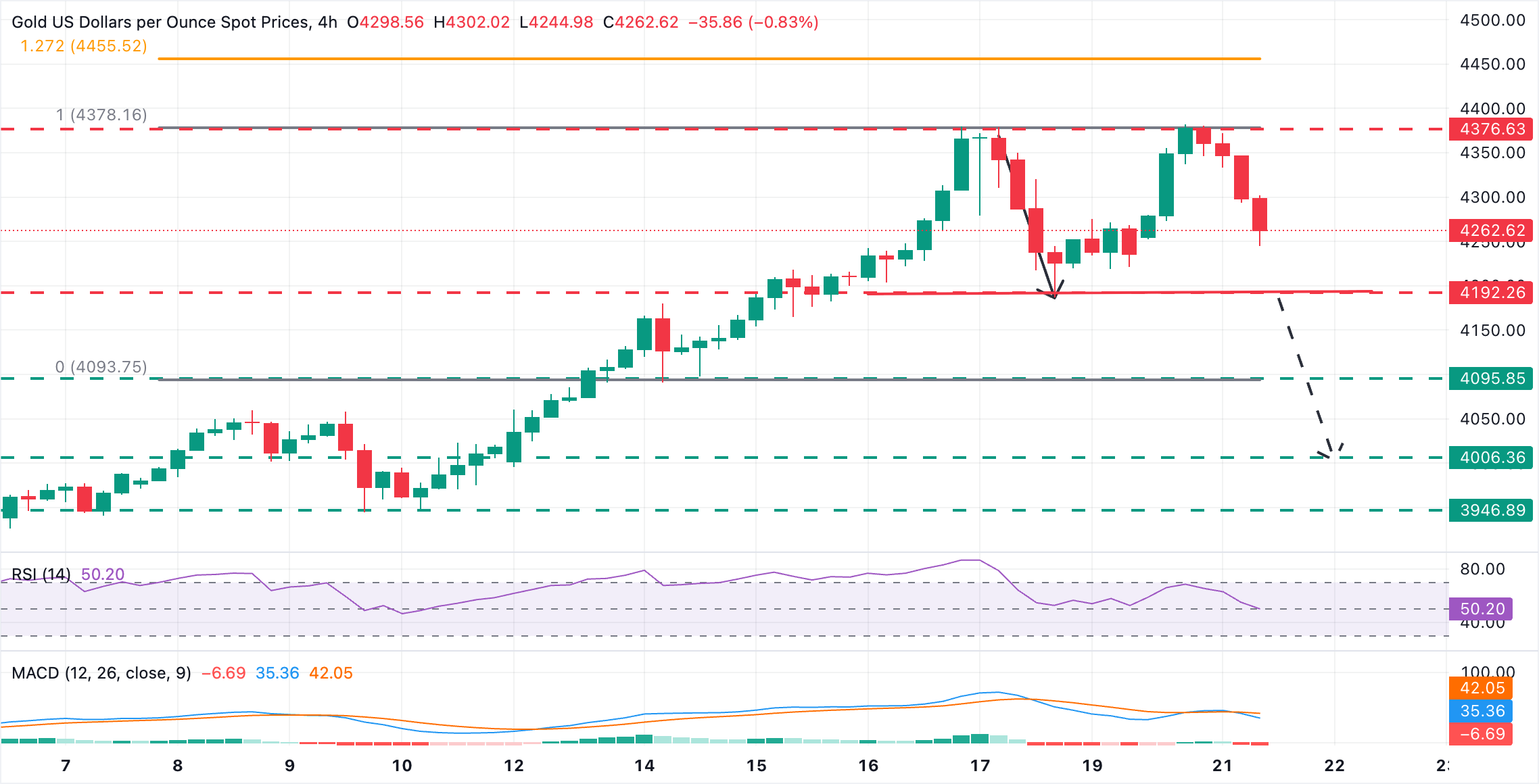Gold Price Forecast: XAU/USD corrects lower, approaching $4,200 area
- Gold retreats from all-time highs at $4,380 and returns to the mid-range of the $4,200s.
- Precious metals struggle as fears of a Sino-US trade war dissipate.
- XAU/USD shows a potential double top at $4,380, a common signal of a trend shift.
Gold was rejected at the $4,380 area for the second time on Monday, and the precious metal has lost more than $100 on Tuesday, reverting the previous day’s gains, with precious metals hammered by an improving market sentiment and a stronger US Dollar.
US President Trump calmed markets on Monday, announcing that he is planning to meet Chinese President Xi next week, and that he is convinced that they will reach a “fair deal”. Trumpo also played down risks of friction on the Taiwan Issue as, he said, China is not planning to invade Taiwan.
Technical Analysis: Potential Double Top at $4,380

The technical picture shows a potential Double Top at $4,380. The precious metal is trading at $4,260 ahead of the US Session opening, drawing closer to the neckline of the DT’s pattern, at the October 17 low of $4,190.
Technical indicators support that view. The 4-hour RSI shows a bearish divergence and is about to cross the key 50 level, while the MACD in the same timeframe has crossed below the signal line, suggesting that the bullish trend has exhausted.
A confirmation below the mentioned $4,190 level would clear the path towards $4,095 (October 14 low). The DT’s measured target is at the $4,000 psychological level.
To the upside, the all-time high, at the $4,380 area, the $4,400 level will pose some resistance. Further up, the 127.2% Fibonacci extension of the October 14-16 rally, at $4,455, emerges as a potential target.
Gold FAQs
Gold has played a key role in human’s history as it has been widely used as a store of value and medium of exchange. Currently, apart from its shine and usage for jewelry, the precious metal is widely seen as a safe-haven asset, meaning that it is considered a good investment during turbulent times. Gold is also widely seen as a hedge against inflation and against depreciating currencies as it doesn’t rely on any specific issuer or government.
Central banks are the biggest Gold holders. In their aim to support their currencies in turbulent times, central banks tend to diversify their reserves and buy Gold to improve the perceived strength of the economy and the currency. High Gold reserves can be a source of trust for a country’s solvency. Central banks added 1,136 tonnes of Gold worth around $70 billion to their reserves in 2022, according to data from the World Gold Council. This is the highest yearly purchase since records began. Central banks from emerging economies such as China, India and Turkey are quickly increasing their Gold reserves.
Gold has an inverse correlation with the US Dollar and US Treasuries, which are both major reserve and safe-haven assets. When the Dollar depreciates, Gold tends to rise, enabling investors and central banks to diversify their assets in turbulent times. Gold is also inversely correlated with risk assets. A rally in the stock market tends to weaken Gold price, while sell-offs in riskier markets tend to favor the precious metal.
The price can move due to a wide range of factors. Geopolitical instability or fears of a deep recession can quickly make Gold price escalate due to its safe-haven status. As a yield-less asset, Gold tends to rise with lower interest rates, while higher cost of money usually weighs down on the yellow metal. Still, most moves depend on how the US Dollar (USD) behaves as the asset is priced in dollars (XAU/USD). A strong Dollar tends to keep the price of Gold controlled, whereas a weaker Dollar is likely to push Gold prices up.

